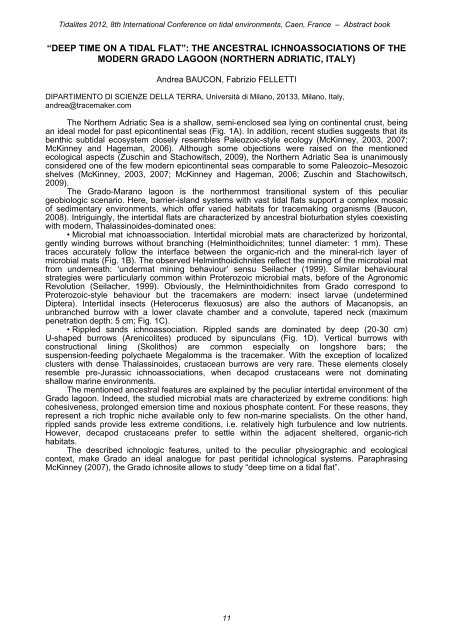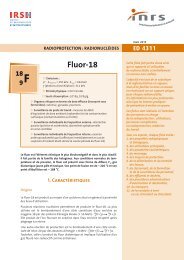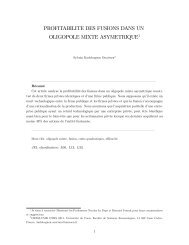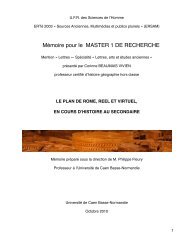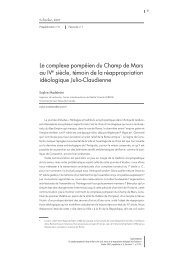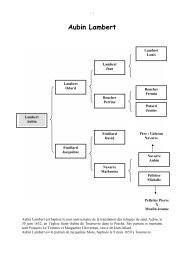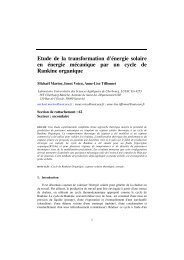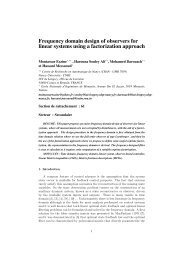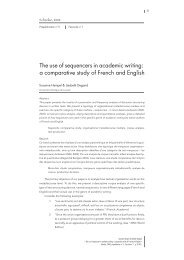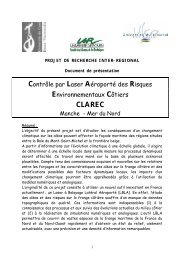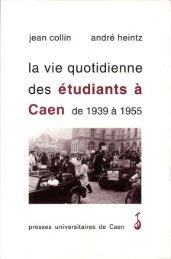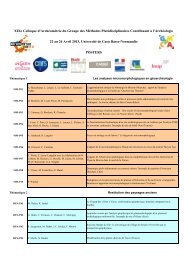programme tuesday, july, 31 - Université de Caen Basse Normandie
programme tuesday, july, 31 - Université de Caen Basse Normandie
programme tuesday, july, 31 - Université de Caen Basse Normandie
Create successful ePaper yourself
Turn your PDF publications into a flip-book with our unique Google optimized e-Paper software.
Tidalites 2012, 8th International Conference on tidal environments, <strong>Caen</strong>, France – Abstract book<br />
“DEEP TIME ON A TIDAL FLAT”: THE ANCESTRAL ICHNOASSOCIATIONS OF THE<br />
MODERN GRADO LAGOON (NORTHERN ADRIATIC, ITALY)<br />
Andrea BAUCON, Fabrizio FELLETTI<br />
DIPARTIMENTO DI SCIENZE DELLA TERRA, Università di Milano, 20133, Milano, Italy,<br />
andrea@tracemaker.com<br />
The Northern Adriatic Sea is a shallow, semi-enclosed sea lying on continental crust, being<br />
an i<strong>de</strong>al mo<strong>de</strong>l for past epicontinental seas (Fig. 1A). In addition, recent studies suggests that its<br />
benthic subtidal ecosystem closely resembles Paleozoic-style ecology (McKinney, 2003, 2007;<br />
McKinney and Hageman, 2006). Although some objections were raised on the mentioned<br />
ecological aspects (Zuschin and Stachowitsch, 2009), the Northern Adriatic Sea is unanimously<br />
consi<strong>de</strong>red one of the few mo<strong>de</strong>rn epicontinental seas comparable to some Paleozoic–Mesozoic<br />
shelves (McKinney, 2003, 2007; McKinney and Hageman, 2006; Zuschin and Stachowitsch,<br />
2009).<br />
The Grado-Marano lagoon is the northernmost transitional system of this peculiar<br />
geobiologic scenario. Here, barrier-island systems with vast tidal flats support a complex mosaic<br />
of sedimentary environments, which offer varied habitats for tracemaking organisms (Baucon,<br />
2008). Intriguingly, the intertidal flats are characterized by ancestral bioturbation styles coexisting<br />
with mo<strong>de</strong>rn, Thalassinoi<strong>de</strong>s-dominated ones:<br />
• Microbial mat ichnoassociation. Intertidal microbial mats are characterized by horizontal,<br />
gently winding burrows without branching (Helminthoidichnites; tunnel diameter: 1 mm). These<br />
traces accurately follow the interface between the organic-rich and the mineral-rich layer of<br />
microbial mats (Fig. 1B). The observed Helminthoidichnites reflect the mining of the microbial mat<br />
from un<strong>de</strong>rneath: ‘un<strong>de</strong>rmat mining behaviour’ sensu Seilacher (1999). Similar behavioural<br />
strategies were particularly common within Proterozoic microbial mats, before of the Agronomic<br />
Revolution (Seilacher, 1999). Obviously, the Helminthoidichnites from Grado correspond to<br />
Proterozoic-style behaviour but the tracemakers are mo<strong>de</strong>rn: insect larvae (un<strong>de</strong>termined<br />
Diptera). Intertidal insects (Heterocerus flexuosus) are also the authors of Macanopsis, an<br />
unbranched burrow with a lower clavate chamber and a convolute, tapered neck (maximum<br />
penetration <strong>de</strong>pth: 5 cm; Fig. 1C).<br />
• Rippled sands ichnoassociation. Rippled sands are dominated by <strong>de</strong>ep (20-30 cm)<br />
U-shaped burrows (Arenicolites) produced by sipunculans (Fig. 1D). Vertical burrows with<br />
constructional lining (Skolithos) are common especially on longshore bars; the<br />
suspension-feeding polychaete Megalomma is the tracemaker. With the exception of localized<br />
clusters with <strong>de</strong>nse Thalassinoi<strong>de</strong>s, crustacean burrows are very rare. These elements closely<br />
resemble pre-Jurassic ichnoassociations, when <strong>de</strong>capod crustaceans were not dominating<br />
shallow marine environments.<br />
The mentioned ancestral features are explained by the peculiar intertidal environment of the<br />
Grado lagoon. In<strong>de</strong>ed, the studied microbial mats are characterized by extreme conditions: high<br />
cohesiveness, prolonged emersion time and noxious phosphate content. For these reasons, they<br />
represent a rich trophic niche available only to few non-marine specialists. On the other hand,<br />
rippled sands provi<strong>de</strong> less extreme conditions, i.e. relatively high turbulence and low nutrients.<br />
However, <strong>de</strong>capod crustaceans prefer to settle within the adjacent sheltered, organic-rich<br />
habitats.<br />
The <strong>de</strong>scribed ichnologic features, united to the peculiar physiographic and ecological<br />
context, make Grado an i<strong>de</strong>al analogue for past peritidal ichnological systems. Paraphrasing<br />
McKinney (2007), the Grado ichnosite allows to study “<strong>de</strong>ep time on a tidal flat”.<br />
11


